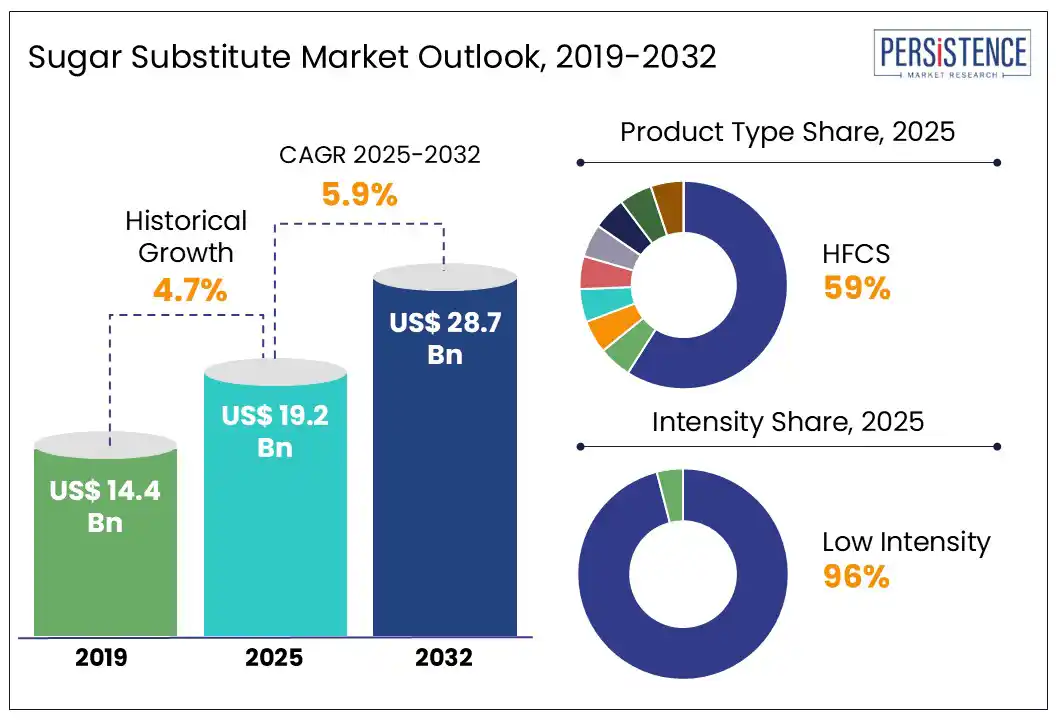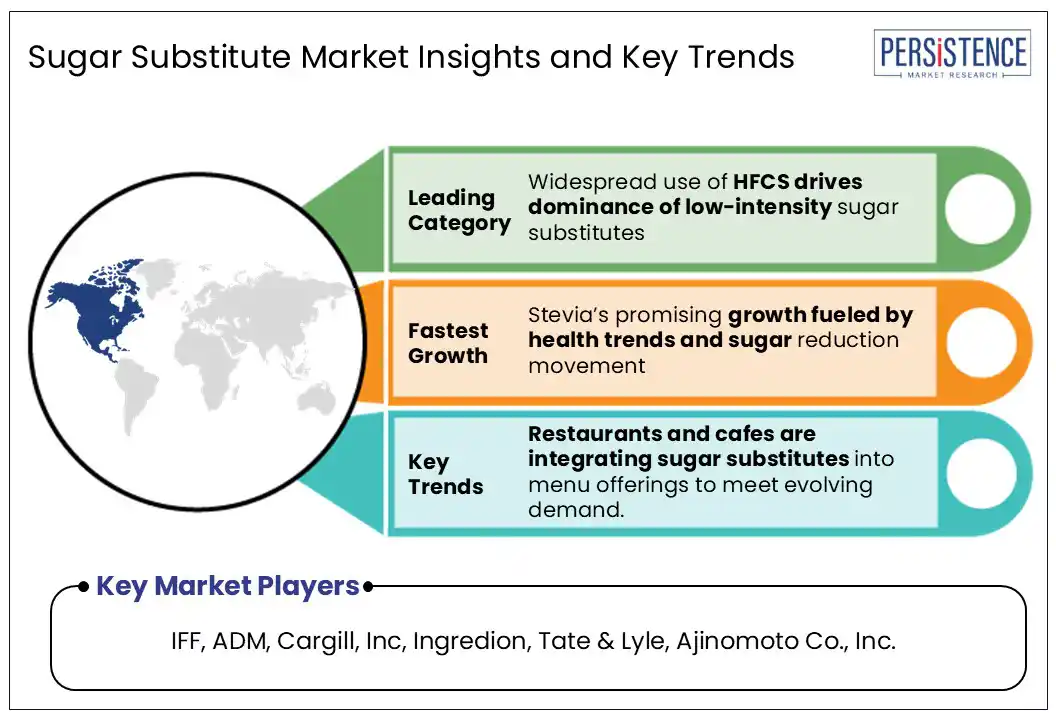ID: PMRREP6850| 191 Pages | 22 Jul 2025 | Format: PDF, Excel, PPT* | Food and Beverages

The global sugar substitute market size is likely to be valued at US$ 19.2 billion in 2025 to US$ 28.7 billion by 2032, growing at a CAGR of 5.9% during the forecast period from 2025 - 2032. According to the World Health Organization (WHO), one in eight people worldwide suffered from obesity in 2022. The prevalence of obesity has more than tripled in the past three decades. Sugar substitutes are gaining popularity worldwide due to their high sweetness and low-calorie content. They are preferred by individuals looking to manage their blood sugar levels, decrease weight, and reduce their calorie intake.
Several food brands are using sugar substitutes to promote their products as healthy. Consumers are showing a rising interest in sugar-free products, thereby providing these substitutes with an impetus for market growth. Food and beverage manufacturers are adopting substitutes in their products as they are enabled to meet the rising demand for sweetened products with zero sugar content.

Key Industry Highlights:
|
Global Market Attribute |
Key Insights |
|
Global Sugar Substitute Market Size (2025E) |
US$ 19.2 Bn |
|
Market Value Forecast (2032F) |
US$ 28.7 Bn |
|
Projected Growth (CAGR 2025 to 2032) |
5.9% |
|
Historical Market Growth (CAGR 2019 to 2024) |
4.7% |
Increasing health concerns, specifically related to diabetes and obesity, are driving robust growth in the sugar substitute market. Consumers are becoming aware of the negative health effects of consuming too much sugar and seek healthier alternatives. As a result, artificial sweeteners, natural sugar substitutes, and sugar alcohols are gaining popularity as they provide sweetness with fewer calories. Growing health consciousness is changing consumer preferences and driving the market toward innovative sweetening solutions, leading to the industry's upward growth.
The sugar alternatives market is being transformed by changing dietary preferences, which are influenced by a global focus on wellness and healthy living. Consumers are actively looking for alternatives to sugar that are low in calories and free of sugar, as they strive to maintain a balanced and nutritious diet. The rapid shift in mind-set is particularly noticeable among the younger population which is prioritizing healthy choices. As the desire for reduced sugar intake gains popularity, sugar alternatives are set to witness an increased demand, especially in beverages, baked goods, and dairy products.
Manufacturers in the keto-friendly sweeteners industry are facing challenges in dealing with complex and constantly changing regulations. Meeting the several international and regional regulations related to food additives, labelling, and health claims is becoming a key obstacle. Health authorities require thorough safety assessments, and different standards in various markets make compliance difficult.
Sugar substitute manufacturers need to invest a substantial amount in research and testing to meet these regulatory requirements, which often result in high costs and product delays. It is hence essential for brands to effectively address these regulatory hurdles to gain market access. They are set to focus on building consumer trust and maintaining growth in this dynamic and heavily regulated industry.
Modern consumers are rapidly turning toward healthy, sustainable, and natural alternatives to sugar. Hence, manufacturers in the food and beverage industry are swiftly adopting novel product formulations and sweeteners. These product innovations are vital in differentiating brands. Businesses are introducing novel formulations like allulose, blended sweeteners, and sugar alcohols to meet consumer demand and stand out in the industry.
They are also innovating sugar alternatives that provide full flavor profile of traditional sugar. They aim to offer their consumer sugar-like experience by adding taste enhancers and other flavor components that mask the undesirable aftertaste of sugar sweeteners. Companies are further exploring a variety of plant-based sweeteners like lucuma, coconut sugar, and yacon syrup that have low glycemic indices and high antioxidant content.
Collaborative partnerships offer a great opportunity for expansion and revenue generation. By forming strategic alliances with food and beverage companies, retailers, or health-focused brands, sugar substitute manufacturers can tap into new distribution channels. At the same time, they can increase the visibility of their products.
Partnering with research institutions or ingredient suppliers can assist in speeding up innovation and getting access to the latest technologies. Through these collaborative networks, sugar alternatives manufacturers can benefit from shared resources, expertise, and market knowledge, leading to growth and a robust position in the competitive industry.
Robust growth in the sugar substitute market is attributed to the rising awareness of health, increasing lifestyle diseases, and consumer preference for low-calorie sweeteners. There is also a substantial rise in the number of people living with diabetes. Consumers across the globe are focusing on weight management. It is creating new opportunities to innovate novel, sustainable, and natural sweeteners that cater to health-conscious consumers.
Consumers are demanding new substitutes of sugar that come in different categories like natural sweeteners, sugar alcohols, and artificial sweeteners. Brands are catering to these preferences and dietary needs by introducing novel products. For instance, in March 2024, Scotty’s Everyday launched its Allulose and Monk Fruit Sweetener Blend, a natural alternative to conventional sugar.
Evolving consumer preferences have led brands to dive into research and development activities. They are striving to find a balance between meeting consumer desire for sweetness in foods and beverages while keeping up with the latest health and wellness trends. It is further giving rise to new and innovative sweetening solutions. The food and beverages industry is working on improving product formulations without sacrificing taste. It is also opening new opportunities for product diversification and the expansion of the stevia products industry.
Low-intensity sugar substitutes hold a staggering market share of 96% as of 2024, driven largely by the widespread use of High-Fructose Corn Syrup (HFCS) across the food and beverage industry. HFCS, being cost-effective and highly functional, is extensively used in carbonated drinks, baked goods, sauces, and ready-to-eat products due to its similar sweetness profile and caloric content compared to regular sugar. These substitutes provide bulk, texture, and taste while fitting seamlessly into existing manufacturing processes. Their compatibility with large-scale production and wide consumer acceptance contributes significantly to their dominance. In contrast, high-intensity sugar substitutes such as stevia and sucralose, although growing in popularity, are primarily used in niche formulations where calorie reduction is prioritized.
Stevia is expected to grow at a leading CAGR in the forecast period 2025 to 2032, driven by rising consumer preference for natural, zero-calorie sweeteners. Extracted from the Stevia rebaudiana plant, it offers high sweetness intensity without raising blood sugar levels, making it ideal for diabetics and weight-conscious consumers.
According to the U.S. Department of Agriculture, the demand for natural sugar alternatives has increased steadily since 2020, aligning with dietary shifts toward clean-label products. The FDA’s GRAS (Generally Recognized As Safe) status for steviol glycosides has further strengthened its acceptance in food and beverage applications. While artificial sweeteners like aspartame are widely used, growing scrutiny over synthetic additives is causing a pivot toward plant-derived solutions. Monk fruit and Advantame are also gaining attention, though their niche appeal and cost barriers may limit broader adoption compared to stevia’s scalable versatility.

North America dominates with a 27% market share as of 2024, driven by growing health consciousness and policy-driven dietary changes. According to the Centers for Disease Control and Prevention (CDC), over 38 million Americans have diabetes, while an additional 97.6 million adults are living with prediabetes, signaling an urgent shift toward sugar alternatives. In response, U.S. regulatory bodies such as FDA have mandated transparent labeling of added sugars, prompting manufacturers to reformulate products.
The dietary guidelines for American population recommends keeping added sugars under 10% of daily calories. Consumers are embracing low- or no-calorie sweeteners to support weight control and manage glucose levels. Demand for sugar-free molasses and natural alternatives in packaged goods continues to surge. In Canada, similar trends are evident, with increasing public awareness around sugar-related health risks and a parallel rise in demand for clean-label sugar substitutes.
Europe sugar substitutes market is expected to show lucrative growth of 5.3% during the forecast period 2025 to 2032, driven by escalating health concerns, evolving consumer preferences, and stringent food regulations. Rising obesity and diabetes projections are prompting food and beverage manufacturers in countries like Germany, the U.K., France, Italy, and Spain to reformulate products with reduced or no added sugar.
Positive safety assessments from the European Food Safety Authority (EFSA) and the U.K. Food Standards Agency (FSA) are facilitating market entry for newer, plant-derived sweeteners. Clean-label demand is rising sharply, as European consumers increasingly reject artificial additives and opt for recognizable, naturally sourced ingredients. In Germany, more than half the population favors sugar-free alternatives, signaling a strong shift in dietary attitudes. Regulatory enforcement on transparency and fair trade practices further fosters trust and drives innovation, positioning Europe as a key region for the advancement of sugar substitute solutions.
The competitive landscape of the global sugar substitute market is growing as demand increases for healthier, low-calorie alternatives to traditional sugar. Major companies are investing heavily in R&D to improve taste profiles, minimize aftertaste, and boost the functionality of natural sweeteners like stevia and monk fruit. Fermentation and bioconversion technologies are being explored to enhance scalability and purity. Firms are also emphasizing clean-label formulations, sustainable sourcing, and regulatory compliance to meet the changing expectations of consumers and governments. The market is seeing more innovation in blended sweetener systems that mix high- and low-intensity ingredients to balance sweetness and cost. Additionally, strategic partnerships and global expansion efforts are underway to strengthen supply chains and tap into new regional markets.
The sugar substitute market is projected to be valued at US$ 19.2 Bn in 2025.
Rising emphasis on health issues is driving interest in the Sugar Substitute Market.
The global sugar substitute market is poised to witness a CAGR of 5.9% between 2025 and 2032
Forming strategic alliances with food and beverage companies, retailers, or health-focused brands is the key market opportunity.
Major players in the sugar substitute market include Cargill, Inc., ADM, IFF, Ingredion, Tate & Lyle, Ajinomoto Co., Inc., Roquette, and others.
|
Report Attribute |
Details |
|
Historical Data/Actuals |
2019 - 2024 |
|
Forecast Period |
2025 - 2032 |
|
Market Analysis |
Value: US$ Bn and Volume: Kilo Tons |
|
Geographical Coverage |
|
|
Segmental Coverage |
|
|
Competitive Analysis |
|
|
Report Highlights |
|
|
Customization and Pricing |
Available upon request |
By Product Type
By Intensity
By Application
By Distribution Channel
By Region
Delivery Timelines
For more information on this report and its delivery timelines please get in touch with our sales team.
About Author